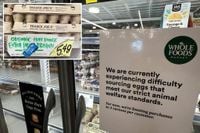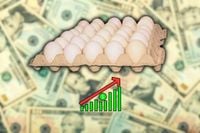As egg prices continue to soar, a significant portion of American consumers is feeling the pinch. According to a recent study by Clarify Capital, over 30% of Americans have ceased buying eggs entirely due to their exorbitant costs. The survey, which included 1,000 participants, revealed that many are waiting for prices to drop to at least $5 per dozen before they consider purchasing eggs again.
Currently, the average price of a dozen eggs stands at $5.18, a staggering increase from just $1.49 in 2018. This price surge is largely attributed to the ongoing impacts of Highly Pathogenic Avian Influenza (HPAI) outbreaks that have severely affected the U.S. egg supply. The Labor Department reported a 58.8% year-over-year increase in egg prices as of February 2025, and the USDA predicts that prices could rise by over 40% this year.
Michael Baynes, CEO of Clarify Capital, emphasized the gravity of the situation, noting that eggs, traditionally a staple in American households, are now being left off shopping lists altogether. “When staples such as eggs cost so much that they qualify as a luxury item in the average home, they put pressure on nutrition, on family budgets, and even mental well-being,” Baynes told FOX Business.
In response to the crisis, the U.S. Department of Agriculture (USDA) has announced plans to invest $1 billion in efforts to combat avian flu, including $500 million for biosecurity measures, $400 million for financial relief to farmers, and $100 million for vaccine research. However, farmers caution that it will take time for these measures to yield significant results.
Since the onset of the bird flu outbreak in 2022, over 166 million birds have been affected, including 127 million egg layers. This has resulted in a substantial loss of production capacity. Economist Bernt Nelson from the American Farm Bureau Foundation noted that the average loss of egg layers since the outbreak began has been about 42.3 million per year, which is approximately 11% of the five-year average annual layer inventory of 383 million hens.
As consumers adapt to the high prices, many are turning to egg substitutes. About 10% of Americans are now relying on alternatives such as plant-based eggs and flaxseed, which offer a temporary solution until prices stabilize.
In Kentucky and Indiana, residents are also feeling the effects of rising egg prices but are faring better than some other states. While local prices hover between $4 and $5 per dozen, they are significantly lower than in states like California, where prices have skyrocketed due to various regional issues. In fact, the average price in Kentucky was $2.83 before the recent surge, indicating that while prices have increased, the state has experienced a relatively smaller impact.
Despite these regional differences, the overall trend is concerning. The USDA's recent reports indicate that while wholesale egg prices have begun to decline, the retail prices consumers see in stores are lagging behind. As of April 2, 2025, wholesale prices fell to $3.00 per dozen, a 9% decrease from the previous week. This decline is attributed to a reduction in avian flu cases, with only 2.1 million birds affected in March compared to 23 million in January.
Stew Leonard, Jr., owner of the Stew Leonard’s grocery store chain, reported that he was selling eggs for $10 a dozen in December, but prices have since dropped to $5.99. “We’re back to low price eggs again. There seems to be plenty of supply,” he stated, reflecting a shift in the market.
However, the USDA cautions that it may take weeks for these wholesale price drops to translate to retail prices. Many grocery stores still have inventory purchased at higher prices and may be reluctant to lower prices too quickly. Costco, for example, continues to limit egg purchases to three per customer, indicating that supply constraints are still a concern.
As the Easter season approaches, demand for eggs typically increases, which could further complicate the price situation. Emily Metz, president and CEO of the American Egg Board, noted that while wholesale prices dropping is promising, the heightened demand around holidays could lead to temporary price increases.
In addition to the challenges posed by avian flu, there are allegations of price gouging within the industry. Advocacy groups have called for investigations into whether major egg producers, who control a significant portion of the market, have manipulated prices. Reports indicate that the top ten producers hold 50% of the market share and have increased prices significantly, even before the outbreak of bird flu.
In summary, while there are signs of improvement in the egg market, with wholesale prices beginning to drop and supply stabilizing, consumers may still face high retail prices for some time. The combination of seasonal demand, ongoing investigations into potential price manipulation, and the long-term effects of avian flu outbreaks will continue to shape the landscape for egg prices in the months ahead.









